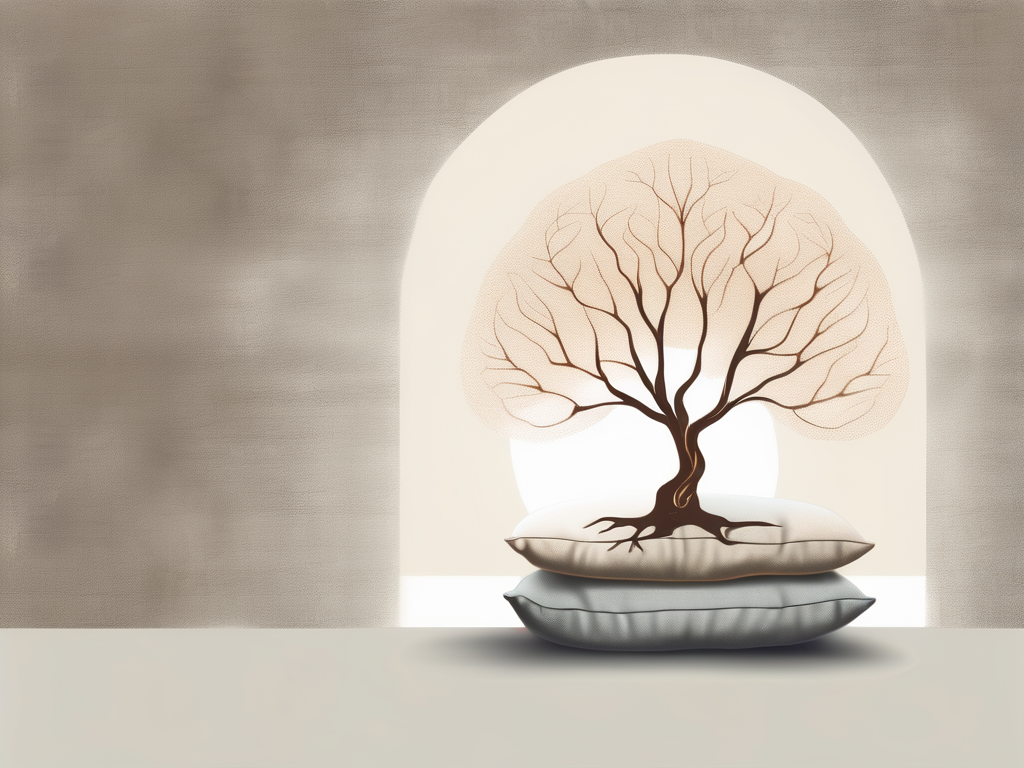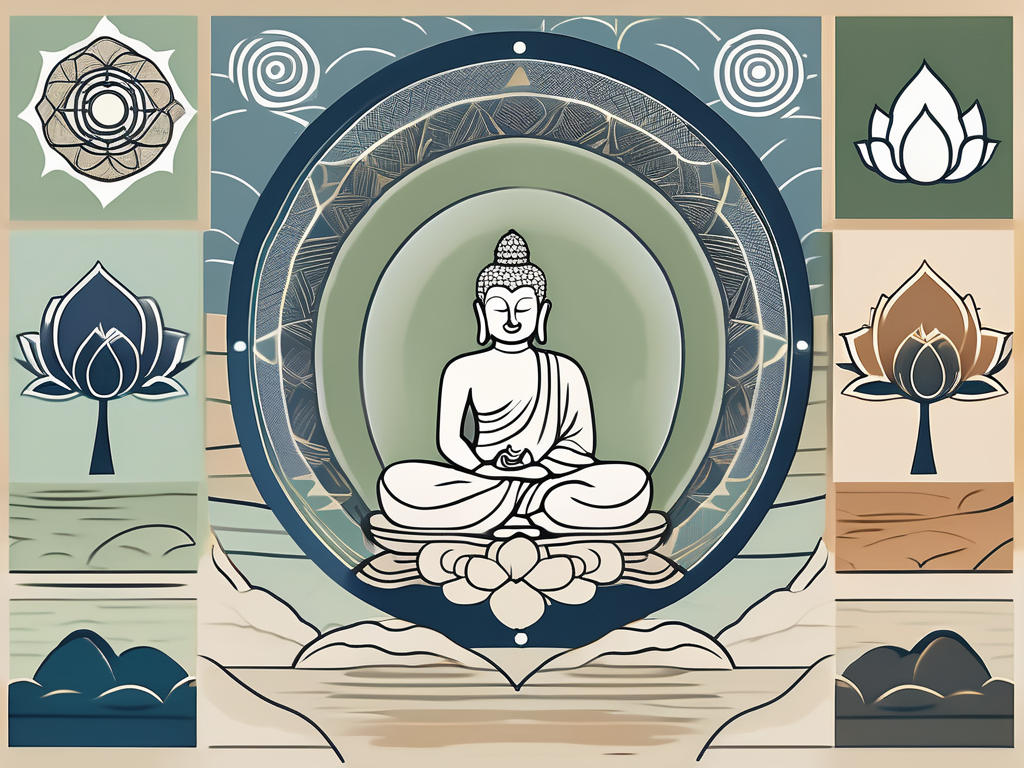Siddhartha Gautama, better known as the Buddha, is one of the most influential figures in religious history. Born in the 6th century BCE in what is now modern-day Nepal, Siddhartha’s life and teachings continue to inspire millions of people around the world. Let’s take a closer look at the man behind the legend and explore the different aspects of his life and legacy.
Understanding Siddhartha Gautama: The Man Before Enlightenment
Before becoming the Buddha, Siddhartha Gautama led a life filled with both privilege and discontent. His early life and family background shaped him into the person he would ultimately become.
Originally part of the Shakya clan, Siddhartha was born into a noble family. His father, King Suddhodana, raised him in comfort and shielded him from the harsh realities of the world. Siddhartha lived a sheltered life within the palace walls, unaware of the suffering that plagued the lives of the common people.
However, as Siddhartha grew older, he felt an increasing sense of dissatisfaction with his luxurious existence. He yearned for a deeper understanding of life and sought to find answers to the universal questions of suffering and the meaning of existence.
This inner yearning led Siddhartha to embark on a spiritual journey that would shape his life and the lives of countless others.
Early Life and Family Background
Siddhartha Gautama was born in Lumbini, a small village in present-day Nepal. Raised by his father, King Suddhodana, and his mother, Queen Maya, he was destined for a life of luxury and power.
As a young prince, Siddhartha had access to the finest education and training. He excelled in his studies and quickly became known for his wisdom and intelligence.
Despite the privileged life he led, Siddhartha was not immune to the suffering that plagued humanity. Deeply affected by the sights of old age, sickness, and death, Siddhartha became determined to find a way to alleviate human suffering.
This determination would drive him to make a life-altering decision.
The Four Sights and the Great Departure
One fateful day, Siddhartha ventured outside the palace walls and encountered the Four Sights. These encounters would change the course of his life forever.
The first sight was an old man, feeble and frail. Siddhartha was struck by the inevitability of aging and the fleeting nature of youth and vitality.
The second sight was that of a sick person, consumed by pain and suffering. Siddhartha was confronted with the harsh reality of illness and the vulnerability of the human body.
The third sight was a funeral procession, with mourners grieving the loss of a loved one. Siddhartha was faced with the omnipresence of death and the impermanence of life.
Finally, the fourth sight was that of a wandering ascetic, renouncing the material world in search of spiritual enlightenment. Seeing this ascetic pursuing a higher purpose, Siddhartha was inspired to follow a similar path.
In a moment of great courage, Siddhartha made the decision to leave behind his life of luxury and venture out into the world in search of answers and spiritual awakening.
Ascetic Life and the Middle Way
In his quest for enlightenment, Siddhartha joined a group of ascetics and embraced a life of extreme self-denial and meditation. He believed that by renouncing all worldly possessions and bodily desires, he could attain spiritual liberation.
For several years, Siddhartha subjected himself to severe austerities, fasting, and enduring harsh conditions. He lived as a wandering ascetic, seeking the truth through self-mortification.
However, despite his efforts, he did not find the answers he was seeking. Siddhartha realized that extreme asceticism was not the path to enlightenment.
Realizing the limitations of extreme asceticism, Siddhartha embarked on a new path, known as the Middle Way. He understood that true enlightenment could not be achieved through self-mortification but rather through a balanced approach to life.
Siddhartha taught the importance of moderation and cultivating a balanced mind and body. He believed that by finding the middle path, one could achieve liberation from suffering and attain true enlightenment.
Through his teachings and personal example, Siddhartha Gautama, the man before enlightenment, laid the foundation for Buddhism and left a lasting legacy that continues to inspire and guide millions of people around the world.
The Path to Enlightenment: Siddhartha Becomes the Buddha
After years of spiritual seeking, Siddhartha Gautama finally reached the pinnacle of his journey. Underneath a Bodhi tree, he experienced a profound state of realization and became the Buddha, which means “the awakened one.”
Siddhartha’s journey towards enlightenment was not an easy one. He had spent years studying under various spiritual teachers, practicing asceticism, and engaging in deep introspection. However, it was through his unwavering determination and relentless pursuit of truth that he was able to attain the ultimate goal of awakening.
As Siddhartha sat beneath the Bodhi tree, the world around him seemed to fade away. His mind became calm and clear, free from the distractions and illusions that had plagued him for so long. In this state of deep meditation, he experienced a profound shift in consciousness.
The Practice of Meditation
Throughout his spiritual journey, meditation played a vital role in Siddhartha’s quest for enlightenment. By training his mind to remain focused and observing his thoughts and emotions with clarity, he was able to gain deep insights into the nature of reality.
Meditation became an essential practice in the Buddha’s teachings, enabling others to cultivate mindfulness, inner peace, and liberation from suffering. Through the practice of meditation, individuals can develop a heightened sense of awareness and a deeper understanding of themselves and the world around them.
By engaging in regular meditation, one can learn to quiet the mind, let go of attachments, and cultivate a sense of inner stillness. This practice allows individuals to tap into their innate wisdom and connect with a deeper sense of purpose and meaning in life.
The Moment of Enlightenment Under the Bodhi Tree
It was under the Bodhi tree in Bodh Gaya that Siddhartha finally achieved enlightenment. Sitting in deep meditation, he transcended the boundaries of his ordinary mind and experienced a profound state of awakening.
During this moment of enlightenment, Siddhartha gained insight into the true nature of existence and the causes of human suffering. He realized the interconnectedness of all phenomena and understood the path to liberation.
As Siddhartha’s mind expanded, he saw that suffering arises from attachment and desire. He understood that by letting go of these attachments and desires, one can attain true liberation from suffering. This realization became the foundation of his teachings and the essence of Buddhism.
Underneath the Bodhi tree, Siddhartha experienced a profound transformation. He became the Buddha, the awakened one, and his journey towards enlightenment became an inspiration for countless others seeking spiritual awakening.
The Buddha’s Teachings and Philosophy
The Buddha’s teachings, known as the Dharma, provide a practical guide for living a fulfilling and meaningful life. Central to his teachings are the Four Noble Truths and the Eightfold Path.
The Four Noble Truths are:
- The truth of suffering: Life is inherently characterized by sorrow and dissatisfaction.
- The truth of the origin of suffering: Attachment and desire are the root causes of suffering.
- The truth of the cessation of suffering: By overcoming attachment and desire, one can attain liberation from suffering.
- The truth of the path to the cessation of suffering: The Eightfold Path provides a roadmap to liberation and enlightenment.
The Four Noble Truths serve as a profound insight into the human condition and offer a framework for understanding and addressing the fundamental causes of suffering.
The Eightfold Path encompasses eight interrelated practices that guide individuals towards spiritual development and moral conduct. These practices include right understanding, right thought, right speech, right action, right livelihood, right effort, right mindfulness, and right concentration.
By following the Eightfold Path, individuals can cultivate a life of wisdom, compassion, and ethical conduct. This path provides a roadmap for living in harmony with oneself and the world, ultimately leading to liberation from suffering and the attainment of enlightenment.
The Buddha’s teachings highlight the importance of compassion, mindfulness, and the cultivation of wisdom as tools for navigating the challenges of life and attaining liberation from suffering. Through the practice of meditation and the application of the Eightfold Path, individuals can embark on their own journey towards awakening and find true peace and happiness.
The Legacy of Siddhartha Gautama: Buddhism’s Spread and Influence
After attaining enlightenment, the Buddha dedicated his life to sharing his teachings and guiding others on the path to liberation. His teachings spread rapidly, influencing countless people across different regions and cultures.
The impact of the Buddha’s teachings was not limited to his immediate disciples. As his message of compassion, mindfulness, and liberation resonated with people from all walks of life, the Buddha’s influence began to reach far beyond the borders of India.
The Formation of the Sangha
The Buddha understood the importance of community and support in the spiritual journey. To provide a space for individuals to deepen their practice and find support, he established the Sangha, a community of monks and nuns.
Within the Sangha, individuals could live a life dedicated to practicing the Buddha’s teachings. By renouncing worldly possessions and committing to a monastic lifestyle, they created an environment conducive to spiritual growth and self-discovery.
Living in close-knit communities, the members of the Sangha supported each other in their spiritual development. They shared their experiences, insights, and challenges, creating a supportive network for those seeking enlightenment.
Buddhism’s Expansion Beyond India
As the Buddha’s teachings gained popularity, they began to spread beyond the borders of India. Missionaries and travelers carried the teachings to neighboring regions, such as Sri Lanka, China, Tibet, and Southeast Asia.
As Buddhism encountered different cultures and traditions, it adapted and evolved, giving rise to distinct forms and practices. In Sri Lanka, for example, the Theravada tradition took root, emphasizing the original teachings of the Buddha and the monastic lifestyle.
In China, Buddhism merged with local beliefs and practices, giving rise to unique schools such as Chan (Zen) Buddhism. This school emphasized direct experience and meditation as a means to enlightenment.
In Tibet, Buddhism integrated with the indigenous Bon religion, resulting in the development of Tibetan Buddhism. This tradition placed a strong emphasis on meditation, ritual practices, and the cultivation of compassion.
Today, there are various schools of Buddhism, each with its unique interpretations and practices. From the Pure Land tradition in Japan to the Vajrayana tradition in Bhutan, Buddhism has taken on different forms while retaining the core teachings of the Buddha.
Modern Buddhism: Variations and Practices
In the modern world, Buddhism continues to evolve and adapt to the changing needs of individuals and societies. Different forms of Buddhism have emerged, ranging from traditional practices to more secular and mindfulness-based approaches.
Some people find solace and spiritual guidance in classic Buddhist practices such as meditation, chanting, and study. They dedicate themselves to monastic life or engage in intensive retreats to deepen their understanding and experience of the teachings.
Others explore new avenues of engagement, incorporating Buddhist principles into their everyday lives. Mindfulness practices, such as mindful eating, walking, and communication, have gained popularity as tools for cultivating presence and reducing stress.
Furthermore, Buddhist principles have been applied to various fields, including psychology, education, and healthcare. Mindfulness-based interventions have shown promising results in reducing anxiety, depression, and improving overall well-being.
Regardless of the form it takes, Buddhism remains a profound source of wisdom and inspiration for those seeking inner peace and liberation. Its teachings continue to guide individuals on the path to awakening, offering a refuge in a world filled with uncertainty and suffering.
Debunking Myths: Common Misconceptions About Siddhartha Gautama
Siddhartha Gautama and his teachings have at times been misunderstood and misrepresented. Let’s address some common misconceptions surrounding his life and philosophy.
The Buddha as a God: A Misunderstanding
Contrary to popular belief, the Buddha did not consider himself a deity or a god. Instead, he saw himself as an ordinary human being who discovered the path to enlightenment through his own efforts.
The Buddha believed that anyone, regardless of their background or social status, could attain enlightenment through diligent practice and self-reflection.
The Buddha’s Lifestyle: Asceticism vs. Middle Way
Another common misconception surrounding the Buddha is related to his lifestyle. While Siddhartha initially embraced extreme asceticism, he later rejected this approach in favor of the Middle Way, a balanced and moderate approach to life.
The Buddha encouraged his followers to practice moderation and avoid extremes in all aspects of life, including self-mortification and excessive indulgence.
The Buddha’s Teachings: Nirvana and Reincarnation
Some misconceptions also exist regarding the concepts of nirvana and reincarnation in Buddhist philosophy.
Nirvana refers to the state of liberation from suffering and the cycle of birth and death. It is not a heavenly realm or an afterlife, but rather the extinguishment of the causes of suffering.
Reincarnation, on the other hand, is a concept associated with Hinduism and other religious traditions, rather than Buddhism. In Buddhism, the idea of rebirth is central, emphasizing the interdependent nature of existence and the continuous cycle of cause and effect.
In conclusion, Siddhartha Gautama, the founder of Buddhism, led a remarkable life and left an enduring legacy. His journey from a sheltered prince to an awakened spiritual leader continues to inspire people to seek truth, cultivate compassion, and live a life of purpose. Through his teachings, Siddhartha Gautama, the Buddha, gave humanity a path to liberation and profound insights into the nature of existence.












